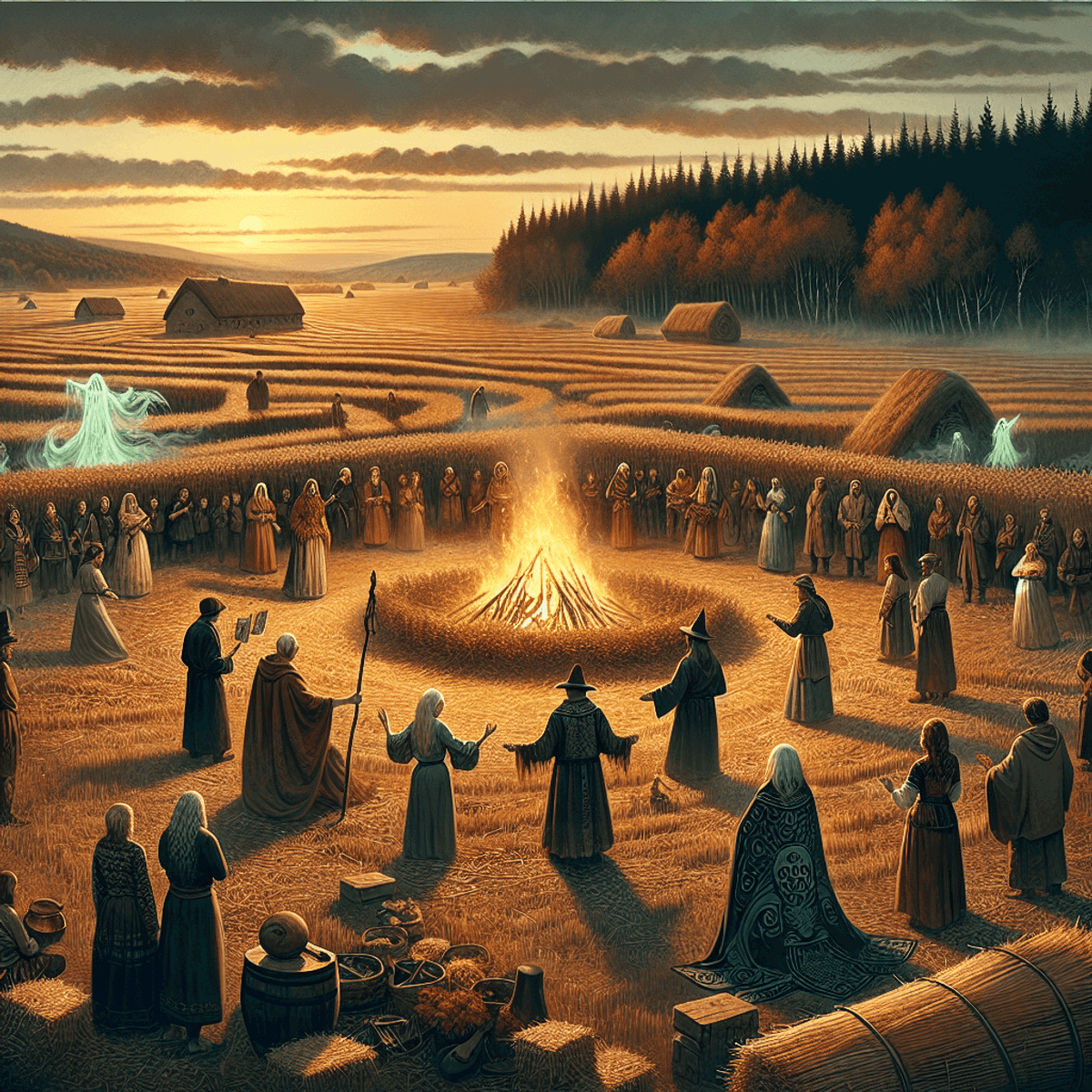The Fascinating History of Halloween: From Samhain to Today

The Fascinating History of Halloween: From Samhain to Today
Halloween has deep roots in ancient Celtic traditions, particularly through the festival of Samhain. This celebration marked the end of the harvest season and the onset of winter, a time believed to be when the boundary between the living and the dead was especially thin.
Key influences on Halloween include:
The return of spirits during Samhain, prompting rituals to honour ancestors and ward off evil, as seen in various folklife traditions associated with this period.
Transformation of Samhain into All Hallow's Eve, leading to modern customs.
Understanding the history of Halloween illuminates its cultural significance. From its origins in Samhain to contemporary practices such as trick-or-treating, appreciating these connections enhances our festive experiences. Embracing this journey through time reveals how deeply intertwined our celebrations are with history and tradition.
The Origins of Halloween: Samhain and Celtic Traditions
Samhain, pronounced sow-in, is an important Celtic festival that marks the end of the harvest season and the beginning of winter. It is celebrated from sunset on October 31 to sunset on November 1, and it held great significance in ancient Celtic societies.
Key Beliefs of Samhain
There were two main beliefs surrounding Samhain:
Return of the Dead: People believed that during this time, the line between the living and the dead became blurred. The souls of deceased ancestors were thought to come back and visit their families, which led to rituals honouring these spirits.
Ward Off Evil: In addition to ancestral spirits, there was also a fear of malevolent beings. To protect themselves from these evil entities, people would light bonfires and wear masks or costumes to disguise themselves.
The Connection Between Samhain and Halloween
The link between Samhain and Halloween can be seen in how it has evolved over time. As Christianity spread, many pagan traditions were incorporated into Christian practices. The church established November 1 as All Saints' Day (or All Hallows' Day), making October 31 All Hallow's Eve, which eventually transformed into Halloween.
How Understanding These Origins Enhances Modern Celebrations
Knowing about these origins adds depth to our understanding of present-day celebrations. The customs associated with Samhain—such as feasting, storytelling, and divination—formed the basis for current Halloween activities. By embracing these historical insights, we can better appreciate the cultural significance behind Halloween festivities today.
From Samhain to All Hallow's Eve: The Evolution of Halloween Traditions
All Hallow's Eve, celebrated on the evening before All Saints' Day, emerged as a significant precursor to modern Halloween festivities. This transition from Samhain to All Hallow's Eve marked a blend of ancient Celtic practices and emerging Christian traditions.
Key Features of All Hallow's Eve
An evening dedicated to honouring saints and martyrs.
Rituals that included lighting candles and offering prayers for the deceased, reflecting the connection to ancestral veneration seen in Samhain.
Over time, customs began to evolve, influenced by various cultural adaptations across regions:
Regional Variations
In Ireland, traditional games and feasting became key elements.
In Scotland, guising emerged, where children would dress in costumes and perform for treats, laying the groundwork for today's trick-or-treating.
As communities absorbed these traditions, distinct customs took shape. The merging of pagan practices with Christian observances led to a rich tapestry of celebrations. Each adaptation contributed layers of meaning, shaping what we now recognize as Halloween. Understanding this evolution provides insight into how ancient rituals have transformed into contemporary customs.
Modern-Day Celebrations: Trick-or-Treating and Beyond
Contemporary Halloween practices have evolved significantly from their ancient roots. Key traditions include:
Trick-or-Treating: Children dress in costumes, visiting homes to collect sweets. This practice stems from the tradition of "souling," where the poor would pray for the dead in exchange for food.
Costume Parties: Social gatherings featuring themed attire have become popular. Participants often choose costumes that reflect current pop culture, ranging from superheroes to classic horror figures.
Haunted Houses: These attractions offer immersive experiences designed to scare participants. They showcase creativity and entertainment, drawing large crowds during the Halloween season.
Commercialization has played a crucial role in shaping modern celebrations. The rise of store-bought costumes and decorations has made it easier for individuals to participate without crafting their attire. Retailers capitalise on the holiday's popularity, offering an array of products that cater to various tastes and budgets.
The blend of traditional elements with commercial influences illustrates how Halloween has transformed into a widely celebrated cultural phenomenon, reflecting both historical significance and contemporary trends.
Embracing Our Roots: The Revival of Traditional Practices
A growing interest in reconnecting with the historical roots of Halloween is evident in various local festivals and community activities that celebrate cultural heritage. This resurgence of folk traditions highlights the desire to honour ancestral customs and strengthen community bonds.
Key practices being revived today include:
Bonfires: Once a central element of Samhain, bonfires are lit to ward off evil spirits and provide a gathering place for communities.
Divination Games: Engaging in traditional games aimed at predicting the future has resurfaced, with activities like apple bobbing and nut roasting gaining popularity during this season.
Storytelling: Sharing spooky tales around the fire fosters a sense of connection with the past while entertaining both young and old.
These revivals not only enrich modern celebrations but also offer a deeper appreciation for the significance behind Halloween's origins. By integrating these traditional elements into contemporary festivities, communities can create a more meaningful experience that honours their shared history.
Global Variations: How Different Cultures Celebrate Halloween
Halloween has evolved into a global celebration, yet its interpretation varies significantly across cultures. Unique customs associated with this time of year reflect local beliefs and traditions.
Mexico: Día de los Muertos
Celebrated on November 1st and 2nd, this festival honours deceased loved ones.
Families create altars (ofrendas) adorned with photographs, favourite foods, and marigolds.
The atmosphere is vibrant, focusing on remembrance rather than fear.
Japan: Obon Festival
Typically held in mid-August, Obon is a time to honour the spirits of ancestors.
It includes traditional dances (Bon Odori) and lantern lighting to guide spirits home.
Families visit gravesites, offering food and prayers.
These examples illustrate how international Halloween celebrations incorporate diverse cultural elements. While the common theme revolves around remembering the dead, the significance and customs can differ widely. This rich tapestry of traditions highlights the myriad ways communities embrace their heritage while participating in festivities that have transcended geographical boundaries.
Conclusion
Halloween has a rich history that traces back to ancient Celtic traditions like Samhain. By understanding its origins better we can appreciate our modern-day celebrations even more!
Key Points:
Embrace Ancient Roots: Remembering where our traditions come from helps us connect with nature & life cycles
Modern Interpretations: Today's celebrations show off creativity & community spirit while bringing joy across cultures
Future Of Traditions : As we carry out these rituals let's think about how they can evolve but still respect their historical importance
So next time you get ready for trick-or-treating or costume parties remember - there's so much more behind this holiday than just fun games! It's an opportunity for all generations come together & celebrate what makes us human - love , loss & everything else in between!
Online Courses
Check out self study online courses





